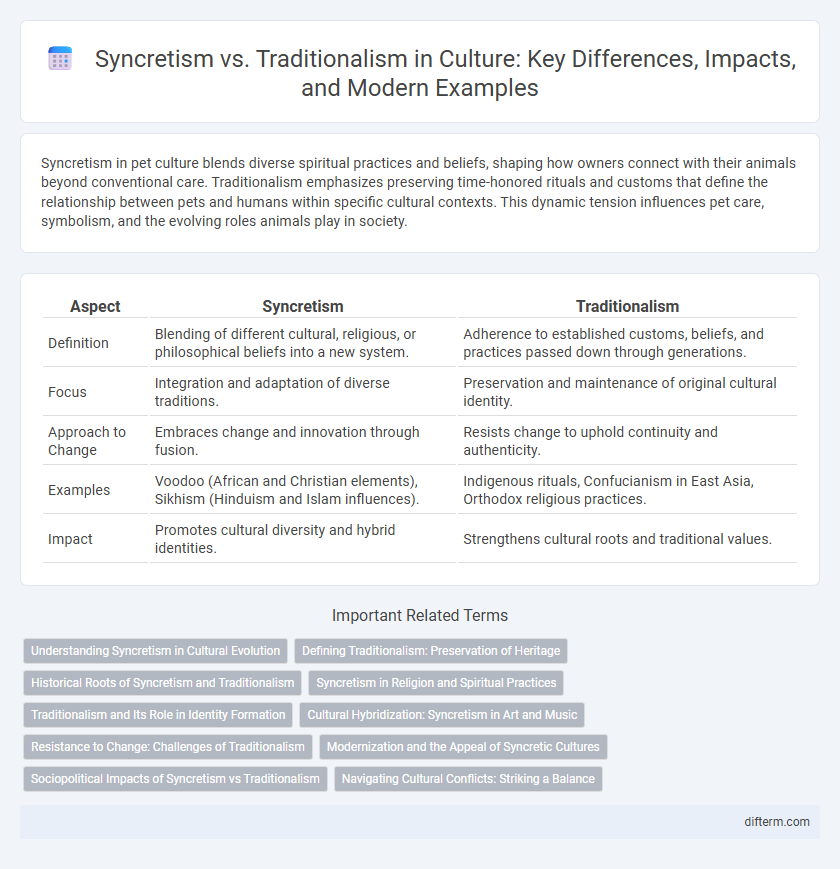Syncretism in pet culture blends diverse spiritual practices and beliefs, shaping how owners connect with their animals beyond conventional care. Traditionalism emphasizes preserving time-honored rituals and customs that define the relationship between pets and humans within specific cultural contexts. This dynamic tension influences pet care, symbolism, and the evolving roles animals play in society.
Table of Comparison
| Aspect | Syncretism | Traditionalism |
|---|---|---|
| Definition | Blending of different cultural, religious, or philosophical beliefs into a new system. | Adherence to established customs, beliefs, and practices passed down through generations. |
| Focus | Integration and adaptation of diverse traditions. | Preservation and maintenance of original cultural identity. |
| Approach to Change | Embraces change and innovation through fusion. | Resists change to uphold continuity and authenticity. |
| Examples | Voodoo (African and Christian elements), Sikhism (Hinduism and Islam influences). | Indigenous rituals, Confucianism in East Asia, Orthodox religious practices. |
| Impact | Promotes cultural diversity and hybrid identities. | Strengthens cultural roots and traditional values. |
Understanding Syncretism in Cultural Evolution
Syncretism in cultural evolution refers to the blending of diverse beliefs, practices, and traditions into new, hybrid forms that reflect interactions between different societies. This process facilitates cultural adaptation and innovation, allowing communities to incorporate external influences while preserving core elements of their identity. Understanding syncretism reveals how cultural transformation often results from dynamic exchanges rather than rigid adherence to traditionalism.
Defining Traditionalism: Preservation of Heritage
Traditionalism emphasizes the preservation of cultural heritage by maintaining established customs, rituals, and values passed down through generations. It seeks to uphold the identity and continuity of a community by resisting changes that may dilute or alter its foundational beliefs. This approach prioritizes authenticity and historical fidelity in cultural expressions, contrasting with syncretism's blending of diverse influences.
Historical Roots of Syncretism and Traditionalism
Syncretism traces its historical roots to cultural exchanges along trade routes like the Silk Road, where diverse religious and philosophical ideas merged to form hybrid belief systems. Traditionalism stems from ancestral customs preserved within isolated communities, maintaining practices and worldviews largely unchanged over centuries. Both approaches reveal how societies negotiate continuity and change, with syncretism often arising in multicultural interactions and traditionalism in resistance to external influences.
Syncretism in Religion and Spiritual Practices
Syncretism in religion and spiritual practices blends diverse beliefs, rituals, and symbols to create hybrid systems that resonate with contemporary cultural contexts, fostering inclusivity and adaptability. This dynamic process often emerges in societies experiencing cultural contact, enabling the integration of indigenous traditions with foreign religious elements, thereby enriching spiritual expression and community identity. Syncretism challenges rigid orthodoxies by promoting a fluid doctrinal approach, which helps religions evolve and remain relevant in multicultural environments.
Traditionalism and Its Role in Identity Formation
Traditionalism plays a crucial role in identity formation by preserving cultural heritage, rituals, and values passed down through generations. It reinforces a sense of belonging and continuity, grounding individuals in a shared history and collective memory. By emphasizing ancestral customs and ancestral wisdom, traditionalism helps maintain distinct cultural identities in the face of globalization and social change.
Cultural Hybridization: Syncretism in Art and Music
Cultural hybridization through syncretism in art and music merges diverse traditions, creating innovative expressions that reflect complex social histories. This fusion blends elements from indigenous, colonial, and global influences, producing unique genres like Afro-Cuban jazz and mestizo visual arts. Syncretic practices challenge traditionalism by fostering dynamic cultural identities that evolve while preserving core heritage components.
Resistance to Change: Challenges of Traditionalism
Traditionalism often faces significant resistance to change due to its deep-rooted commitment to preserving established cultural practices and values. This resistance can result in social friction when new ideas or external influences challenge long-standing beliefs. The challenge lies in balancing respect for heritage with the need for cultural adaptation in a dynamic world.
Modernization and the Appeal of Syncretic Cultures
Syncretism blends diverse cultural beliefs and practices, fostering innovation and adaptation crucial in modernization processes. Traditionalism emphasizes preserving established customs and values, often resisting rapid cultural changes to maintain social cohesion. The appeal of syncretic cultures lies in their flexibility to integrate global influences while retaining local identities, enabling dynamic responses to contemporary challenges.
Sociopolitical Impacts of Syncretism vs Traditionalism
Syncretism fosters social cohesion by blending diverse cultural and religious elements, often promoting inclusivity and adaptability in sociopolitical systems. Traditionalism emphasizes preserving established customs and authority, which can strengthen group identity but may resist change and marginalize minority perspectives. The tension between syncretism and traditionalism shapes policy development, national identity, and conflict resolution strategies within multicultural societies.
Navigating Cultural Conflicts: Striking a Balance
Syncretism fosters cultural innovation by blending distinct traditions into cohesive new practices, enriching social identity and promoting inclusivity. Traditionalism emphasizes preserving established customs, ensuring cultural continuity and reinforcing community values through generations. Navigating cultural conflicts requires balancing syncretic adaptation with respect for traditional norms to create harmonious coexistence and mutual understanding.
Syncretism vs Traditionalism Infographic

 difterm.com
difterm.com